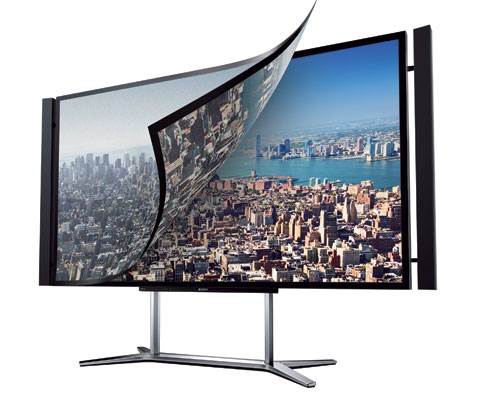Ultra HD broadcasts could be here
sooner than we think as SES Astra and Eutelsat make plans for test
transmissions
As well as being enthusiastic fans of
satellite TV, many What Satellite & Digital TV readers will also access
services via broadband using cable or telephone networks. The non-stop
publicity and propaganda that flows from some of the ‘fixed line; service
providers suggest that it is only a matter of time until we can abandon our
dishes and instead rely on ’catch-up’ transmissions delivered to our TVs.

The
NDS Fresco video wall concept can be adapted to a multitude of shapes
Not so. In around three years the first
Ultra HDTV transmissions will begin to regularly beam out spectacular 4000-line
services to some European countries. We are not yet sure that BSkyB will be an
early adopter, but there’s little doubt that SES Astra and Eutelsat will begin
to make its first test transmissions within the next year or so.
Indeed, Astra used the giant IBC trade show
in Amsterdam to beam 4000-line signals to a giant and a $37,500 price tag 84in
Sony Bravia display. The images were truly spectacular, and attracted crowds
some of whom examined the set extremely closely to try and see the
near-invisible pixels!
Today’s HDTV signals are increasingly
becoming the normal way we watch TV (and HDTV represents about 13 percent of
the satellite operator’s typical market). This is set to grow as standard
definition transmissions are phased out, probably by 2015-16 for most ‘western’
nations.
The CEO of Astra, Romain Bausch, said in
September that he expects Ultra HD to be commercialized starting in 2015 or
2016 in the United Sates and major European markets and for it to become
mass-market between 2015-2020. Bausch said that while Ultra HD will require
about twice the bandwidth as HDTV, broadcasters will provide programming for
it, and distribute it, once they see customers purchasing Ultra HD-compatible
televisions, which are now being commercialized but remain too costly for most
people today.
Ultra price
That will change, and prices will fall. The
head of DirecTV’s space & communications division in California, Philip
Goswitz, agrees. “Chip manufacturers are making cheaper products 9for Ultra
HDTV). Yes, the TV sets are now $20,000. High-definition in 1998 was much the
same, and 2005 was the watershed moment for HDTV adoption. I hope things are
going to evolve more quickly this time around”, Goswitz said. “We are going to
want to have it in place and we will use Ku-band for it (over the USA)”.
‘Compression will continue to improve. We
cannot play King Canute and try to hold back the tide”, says Michel de R., CEO
at Eutelsat, whose core revenue base is video distribution. “But the higher
compression creates the conditions for adoption of higher resolution. De R.
said 4K, an emerging technology standard for Ultra HD, will start in cinemas
but move into the television market in the next three years.

Highly
efficient and so-called edgeless, panels that will do the job just as well and
are perhaps more suitable for some of our homes
In other words, start saving now for your
next flat panel screen! But is this a sound decision? I ask because some other
experts think we should all start moving away from costly although attractive
displays from the likes of Sony, Samsung, Panasonic and LG and others, and
start thinking instead about ‘panels’. Highly efficient and so called edgeless,
panels that will do the job just as well and are perhaps more suitable for some
of our homes. If we are living in a very typical British semi-detached home
where viewers tend to site their TV set besides a fireplace (or perhaps in the
hole left by the removal of a fireplace) then we might not have the option of a
‘video wall’.
Video wall
But Cisco-owned NDS (which also supplies
the Sky ‘smart card’ encryption system) believes a move a video walls is
inevitable. They call their concept ‘Fresco’ and it can be adapted to a
multitude of shapes. In fact some people believe that in a few years from now
we will visit our local do-it0yourself and order up a panel of OLED (Organic
Light-Emitting Diode) displays by the square meter, just like floor tiles or
even wallpaper.

Sony’s
84in Ultra HDTV, costing around $37,500
The NDS concept is that viewers (and
broadcasters) will want to use giant screen areas to exploit the existing
metadata that is the millions of messages, weather, news, sports scores as well
as social media-type information that every important TV show now generates. Of
course, 4000-line displays also permits viewers to enjoy breathtaking TV
images, whether of sport, or movies or travel/natural history programming.
Start saving!